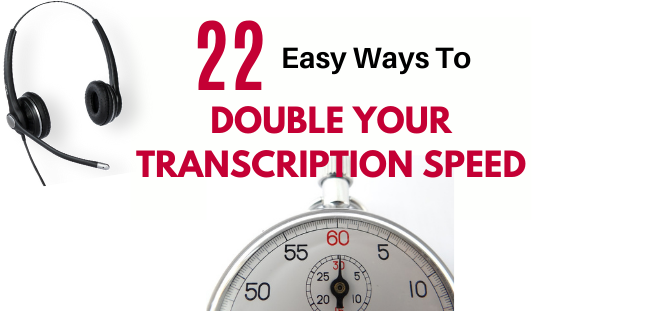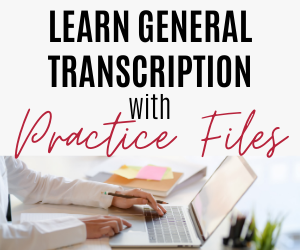22 Ways to Transcribe Faster
How can you transcribe faster? Do you want to become a faster and better transcriptionist? How can you make transcription easier?
Your typing and transcription speed are important to make good money as a transcriptionist.
When you can transcribe fast, you’ll get more work done in less time. You’ll be able to get additional transcription jobs that require a fast turnaround time (TAT) and you can get better paid transcription jobs.
Of course, regardless of your speed, it’s essential to provide accurate transcripts.
Here are 21 tips to increase your transcription speed and productivity and become a faster transcriptionist:
1 – Use a good computer.
Use a computer with a fast processor. And don’t have more programs open than you need.
2 – Improve your typing skills.
To become a fast typist, you must use the correct fingers for the different keys and type without looking at the keyboard. Typing tutorials provide exercises that will help you improve your touch-typing skills, increase your typing speed and improve your accuracy.
3 – Using transcription software will double your transcription speed.
Transcription software opens the digital audio file and allows the transcriptionist to listen to the recording and type what they hear. The software can stop, forward, rewind, slow down or speed up the recording to make typing easier and faster.
Check out Express Scribe, FREE, popular transcription software.
NOTE: You need to use audio playback software – NOT speech recognition software to do transcription work.
Article: What is the best transcription software.
4 – A foot pedal will instantly help you transcribe faster.
Using a foot pedal will instantly increase your transcription speed. The foot pedal allows you to pause, forward and rewind the audio while keeping your hands free for typing.
Article: How to choose a foot pedal.
AltoEdge Transcription Foot Pedal Bundle
5 – Use a good quality headset.
A headset will give you better, clearer sound, blocks out noises in your environment, helps you hear better what’s being said and will increase transcription speed and accuracy. You’ll have to rewind less often and will get the job done faster.
Article: How to choose a headset for transcription.
6 – Practice to increase your transcription speed and accuracy.
Download free transcription software, install a foot pedal and practice transcribing anything you hear. Your transcription speed will keep increasing with practice.
The best way to learn general transcription is by taking a specialized course or using transcription practice files. It will speed up the learning process, help you get started faster, make you a better transcriptionist and help you get higher paying jobs. Check out my general transcription practice files.
7 – Take a transcription course
Taking a course will speed up your learning curve tremendously. And it will teach you how to do transcription correctly. I recommend this detailed, multi-media general transcription course.
If you're not ready to get started in transcription or to take a course, you can explore a career in general transcription with my FREE general mini-course.
8 – Adjust the speed of the audio as needed.
Set the speed of the audio to match your typing speed. When slowing down the audio you will have to pause and rewind the audio less often. Speed up the tape when people are talking slowly. After completing the transcript, relisten to the audio at high speed to check and edit it.
9 – Use sound editors.
Sound or audio editors can filter out noise and enhance the audio so you can hear the voices better. They can make it easier to transcribe bad quality recordings. Audacity is a great free sound editor.
10 – Learn Word’s Time-Saving Features.
Word has many features that can tremendously increase your transcription speed, including AutoCorrect, AutoText, AutoComplete, Building Blocks and shortcut keys. Make sure to become familiar with them. Also, learn common formatting features you’ll often need for transcripts such so as setting up margins, headers, footers, page numbering and indents so you don’t waste time when formatting your transcripts.
Read my blog post: How to increase your transcription speed with shortcut keys.
11 – Use Word’s built-in dictionary and thesaurus.
You can quickly look up words you don’t understand with Word's built-in dictionary and thesaurus.
12 – Instantly transcribe faster with text expanders.
Text expanders, also called word expanders can save transcriptionists over 30% of keystrokes, speed up transcription, minimize mistakes and increase accuracy. You create a shortcut for a word, phrase, sentence, paragraph, document, and when you type in the abbreviation, the program will expand it. There are many text expanders available. Start by using the Autocorrect feature that comes with Microsoft Word. Read more about text expanders here.
13 – Set up transcription templates to transcribe faster.
Save time by setting up templates for the type of work you often do. Set up transcription templates for each type of transcription you often do. For example, set up templates for two-person interviews with interviewer and interviewee, multiple speaker interviews, focus groups, meeting minutes, oral history, legal pleadings, apa style report, MLA style research template for academic work and more. Templates can include margins, titles, headers, footers, page numbering, paragraph spacing, indentation, font type/size and more
14 – Avoid distractions, external noises and interruptions from other people.
As much as possible, work in a quiet environment where you’ll get the least amount of distractions.
15 – Get good audio quality.
Make clients aware that the quality of the recording will affect the quality of the transcript and provide tips to improve the quality of their recordings.
16 – Communicate with your clients about their transcription needs.
Ask what kind of transcript they want, what the purpose of the transcript is and what information is important to them. Inform clients that the type of transcript they need will affect the time to transcribe it and the cost. Strict verbatim transcription will take longer to transcribe than intelligent verbatim. Intelligent verbatim transcription cuts out redundant words, repeats, pauses, ‘ums’ and the ‘ers’, fillers such as kind of, sort of, you know. Find out if you can skip parts of the content that are unimportant to them and save transcription time. You may not need to transcribe background noise and other sounds that are not made by the participants.
17 – Ask for documentation.
Ask clients to provide a list of unusual words or other documentation that includes many of the terms used during the recording such as the name of the project, jargon and any technical, specialty, abbreviations or other unfamiliar terms. Ask for the speakers’ names and other names mentioned or ask to spell them at the beginning of the recording.
17 – Transcribe topics you’re familiar with.
When getting started, start with easier jobs that don’t include specialized terminology and work for industries you’re familiar with. If you’re transcribing topics you’re not familiar with, you’ll have to do some research and look up unfamiliar words which will slow you down.
19 – Become familiar with the terminology and jargon of the industries you're transcribing for.
Each industry has specific terminology and jargon associated with it. Become familiar with them. The longer you work with the same company or industry, the more familiar you will be with the words and phrases that they use. To become faster at transcribing certain topics and be able to figure out hard-to-hear words, look up the definitions, meaning and spelling of words your clients often use.
20 – Learn how to research information online.
When you become proficient at Internet research, you can quickly and easily learn about any topics you need to know more about.
Here's a good article on how to research information online.
21 – Compile your own research materials.
Compile a list of words you often encounter for the industries you're working with. Keep a list of specialized words handy for reference. Set up shortcuts for those words with text expanders.
22 – Collect resources.
Look for specialized dictionaries and glossaries online. Here are some resources to help you learn some spellings and definitions.
Abbreviations & Acronyms Dictionary
OneLook Dictionary Search
Make sure to implement those tips to increase your transcription speed. Increasing your speed, accuracy and efficiency will affect your turn-around time and help you become a more proficient and in-demand transcriptionist.
Tools to help you become a faster transcriptionist
- Type faster with typing expanders or word expanders.
- Transcribe faster with Phrase Express Text Expander
Not sure if general transcription is right for you?
Explore a career in general transcription
with my FREE general mini-course
Ready to get started in general transcription?
Although formal training is not required, I encourage beginners to get specialized training. Taking a specialized transcription course will get you started right. It will speed up the learning process, help you get started faster, make you a better transcriptionist and help you get higher paying jobs.
Get this online, detailed, multi-media general transcription course now
Janet’s course includes typing drills, transcription skills, transcription formats, grammar skills, Word formatting tips, lots of practice files and much more.
RESOURCES
Detailed, multi-media general transcription course now
Practice general transcription with transcription practice files.
Important TIP: Use correct spelling.
You’ll lose credibility if you’re having typos and grammar mistakes on your site. Grammarly is the best online spelling and grammar checker. It detects grammar, spelling, punctuation, word choice, and style mistakes as you write Word documents, emails, and content on your website or social media. It’s better than Microsoft Word’s grammar checker. Just add the Grammarly plugin to Google Chrome and it will check your emails, social media posts or blog posts and everything else you write.
Grammarly has a free version and premium version. Check it out here.
TRANSCRIPTION RESOURCES
- FREE General Transcription Mini-Course.
- Detailed, multi-media General Transcription Course.
- General Transcription Practice Files.
- FREE Legal Transcription Mini-Course.
- Check out this complete transcription starter kit at Amazon.
- Grammarly is the best online spelling and grammar checker to help you edit your transcripts. Grammarly has a free version and a premium version. Check it out here.
Disclaimer: If you purchase a product through a referral link, I will get a commission at NO extra cost to you and it helps me to keep providing you with quality information.



